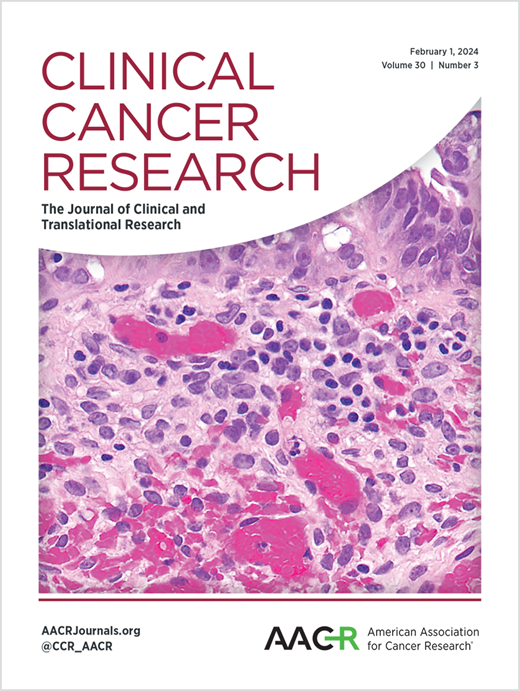Porustobart (HBM4003) plus toripalimab as second-line therapy in patients with advanced hepatocellular carcinoma: a multicenter, open-label, phase I study
IF 10
1区 医学
Q1 ONCOLOGY
引用次数: 0
Abstract
Purpose: To evaluate porustobart (HBM4003), a novel anti-CTLA-4 monoclonal antibody, combined with toripalimab as second-line therapy in advanced HCC. Patients and Methods: This phase I study included two cohorts of patients with advanced HCC: cohort 1 included patients who were anti-PD-1/PD-L1 naïve and had received first-line anti-VEGFR- tyrosine kinase inhibitor; cohort 2 included patients who had failed prior first-line anti-PD-1/PD-L1 and anti-VEGF/VEGFR therapies. Porustobart (0.45 mg/kg) and toripalimab (240 mg) were administered every 21 days. The primary endpoint was the objective response rate (ORR). Results: Totally, 16 patients were enrolled in cohort 1 and 12 in cohort 2. In the 26 patients with evaluable efficacy data, ORR was 23.1% (95% CI 9.0-43.6). Cohort 1 exhibited an ORR of 40.0%, while cohort 2 presented no objective response. The median progression-free survival was 4.2 months, with 5.7 months for cohort 1 and 3.8 for cohort 2. Biomarker exploration revealed higher abundance of intratumoral Tregs in responders before treatment, and a substantial elevation of CD4+Ki67+ and CD8+Ki67+ T cells after treatment. For safety, treatment-emergent adverse events were reported in 27 (96.4%) patients, treatment-related adverse events (TRAEs) were reported in 25 patients (89.3%), among whom 13 (46.5%) had grade ≥3 TRAEs. Serious adverse events (SAEs) were observed in 12 patients (42.9%), and treatment-related SAEs were observed in 9 (32.1%) patients. Conclusions: The combination of porustobart and toripalimab shows promising efficacy as a second-line therapy in anti-PD-1/PD-L1 naïve patients with advanced HCC and a manageable safety profile. Trial Registration: ClinicalTrials.gov identifier: NCT05149027.Porustobart (HBM4003)联合torpalimab作为晚期肝细胞癌患者的二线治疗:一项多中心、开放标签、I期研究
目的:评价新型抗ctla -4单克隆抗体porustobart (HBM4003)联合托利单抗作为晚期HCC的二线治疗。患者和方法:该I期研究包括两组晚期HCC患者:队列1包括抗pd -1/PD-L1 naïve并接受一线抗vegfr -酪氨酸激酶抑制剂治疗的患者;队列2包括先前一线抗pd -1/PD-L1和抗vegf /VEGFR治疗失败的患者。Porustobart (0.45 mg/kg)和toripalimab (240 mg/kg)每21天给药一次。主要终点为客观缓解率(ORR)。结果:队列1共纳入16例患者,队列2纳入12例患者。在26例具有可评估疗效数据的患者中,ORR为23.1% (95% CI 9.0-43.6)。队列1的ORR为40.0%,而队列2无客观反应。中位无进展生存期为4.2个月,队列1为5.7个月,队列2为3.8个月。生物标志物探索显示,治疗前应答者的瘤内Tregs丰度较高,治疗后CD4+Ki67+和CD8+Ki67+ T细胞显著升高。安全性方面,27例(96.4%)患者报告了治疗引起的不良事件,25例(89.3%)患者报告了治疗相关不良事件(TRAEs),其中13例(46.5%)患者TRAEs≥3级。12例(42.9%)患者出现严重不良事件,9例(32.1%)患者出现治疗相关不良事件。结论:porustobart联合torpalimab作为抗pd -1/PD-L1 naïve晚期HCC患者的二线治疗具有良好的疗效,且安全性可控。试验注册:ClinicalTrials.gov标识符:NCT05149027。
本文章由计算机程序翻译,如有差异,请以英文原文为准。
求助全文
约1分钟内获得全文
求助全文
来源期刊

Clinical Cancer Research
医学-肿瘤学
CiteScore
20.10
自引率
1.70%
发文量
1207
审稿时长
2.1 months
期刊介绍:
Clinical Cancer Research is a journal focusing on groundbreaking research in cancer, specifically in the areas where the laboratory and the clinic intersect. Our primary interest lies in clinical trials that investigate novel treatments, accompanied by research on pharmacology, molecular alterations, and biomarkers that can predict response or resistance to these treatments. Furthermore, we prioritize laboratory and animal studies that explore new drugs and targeted agents with the potential to advance to clinical trials. We also encourage research on targetable mechanisms of cancer development, progression, and metastasis.
 求助内容:
求助内容: 应助结果提醒方式:
应助结果提醒方式:


